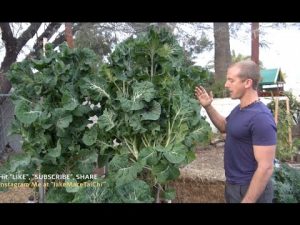 Okay, we’re not lazy gardeners, really.
Okay, we’re not lazy gardeners, really.
We just want to reap the best harvest we can with the least amount of effort.
Perennial plants really fit the bill here, because you only have to baby them from seed to maturity once, instead of playing the repeat-game every growing season.
A single pear tree, for example, will start producing fruit after just 2-4 years. At maturity it will yield over 90 pounds of fruit every single year, often with very little maintenance.
Got a small yard with no space for an orchard? You can try planting a grafted marvel like these “fruit salad” apples, peaches, pears, plums, or even cherry and citrus trees.
Different varieties grow on the same trunk, so they can cross-pollinate each other. One tree is all you need, and you can start harvesting in as little as five years.
Although fruit and nut trees are the obvious perennial food sources, they do take some time and patience to get established.
Edible ladnscaping is a brilliant concept that’s gaining ground, especially in urban areas where people are out of touch with their food sources.
This excellent site gives a huge list of perennial veggies, fruits, and herbs that will reap a harvest THIS year, and also the next!
 Get the starter kit here on Amazon!
Get the starter kit here on Amazon!
Asparagus is one of the easiest perennial plants to grow, and a personal favorite of mine. You can plant “crowns”, which will yield asparagus spears and feathery growth in a matter of weeks. These are truly perennial, and are a wonderful treat in the early spring, when few other mineral-rich foods are in season.
Wispy, fern-like asparagus can be planted under trees, tucked between herbs, and so on. We definitely encourage companion planting in the garden AND the general landscape whenever possible!
However, when planting perennial veggies or fruits, be sure to think twice about their location, including the plant’s mature height and spread.
Something like a mature swiss chard or tree collard plant will have a more imposing profile in your garden landscape!

Some perennials will cast a fair amount of shade on the plants nearest them, so they may do better off to the North or East side of the garden, to make sure the rest of your sun-loving plants aren’t shaded out.
You can even make use of the shade cast by a happy kale or swiss chard plant to provide shelter for more tender plants. Sweet peas, for example, may do better with a little extra shade from the afternoon sun in hotter climates.
This is called utilizing your microclimates, and it’s a great way to get the most out of your yard, especially if you’re working with limited space.
Ready to add some perennial food plants into your landscape? This book is the holy grail of information on growing food the lazy way!
 Get the book here on Amazon!
Get the book here on Amazon!




